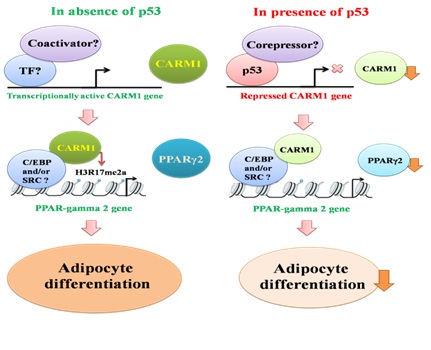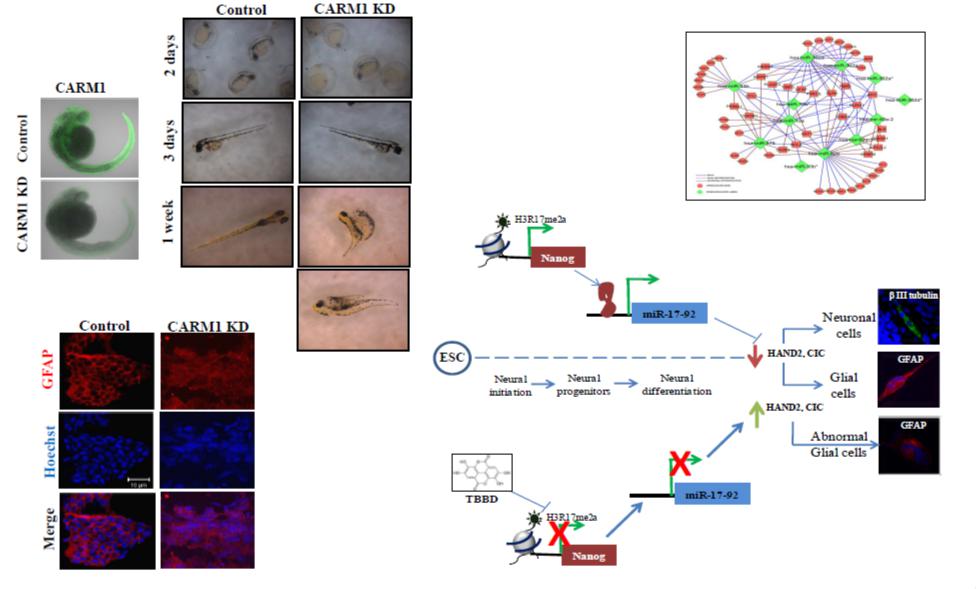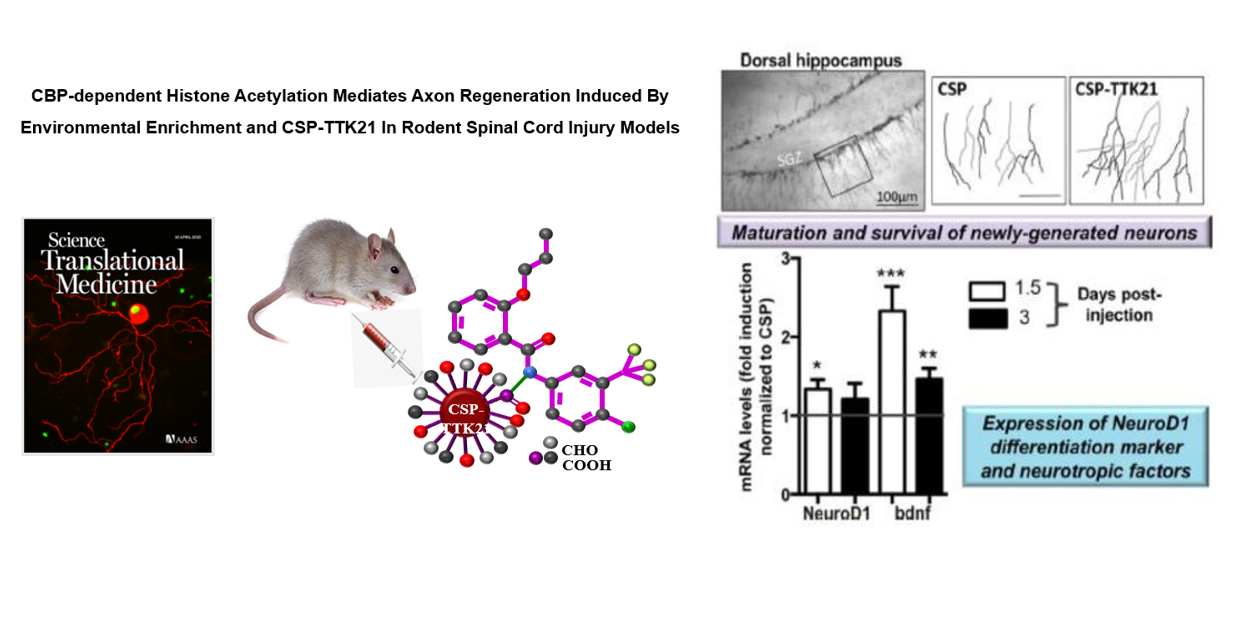Focus of my group is to understand the different aspects of functional chromatin dynamics which are responsible for the gene regulation and its link to cellular physiology, differentiation and pathobiology. Apart from cell cycle regulation, muscle differentiation and neuroglial differentiation, we are investigating two different diseases in this context, namely cancer (oral cancer and breast cancer), and neurodegenerative disorders. Remarkably we have shown that the specific activation of p300/CBP by small molecule activator could result in almost complete recovery of memory in the neurodegenerative disease model. This activation could also dramatically lead to repairing of spinal injury in mice and rat.
Significant Research Contributions:
Tumor suppressor p53 regulate Adipogenesis Epigenetically:
In this study our group have discovered that p53 mediated regulation of expression of CARM1, a well-known transcriptional coactivator and arginine methyltransferase, negatively impacts fate of adipocyte differentiation. We demonstrated that p53 gets recruited to CARM1 promoter and represses its expression. When CARM1 expression is not repressed by p53, CARM1 induces and maintains PPARγ2 expression, which is essential for normal adipogenesis. Further transcriptome analysis and gene network modeling revealed multiple pathways along with lipid biogenesis pathway also to be modulated by p53 in preadipocytes. The experimental evidences on p53 mediated repression of CARM1 expression seem to bridge the mechanistic gap within the regulatory influence of p53 on PPAR-γ expression in adipocytes. This would illuminate our understanding on metabolism of glucose and lipid at organismal level with a molecular basis and allow to address obesity and associative complications such as diabetes with better scientific preparedness.

• Behera AK., Bhattacharya A, Vasudevan, and Kundu TK* (2018), p53 mediated regulation of Coactivator associated arginine methyltransferase 1 (CARM1) expression is critical for suppression of adipogenesis, FEBS J: 285(9):1930-1944.
Chromatin Dynamics Regulated by non-histone chromatin proteins:
Our group has discovered that the highly abundant, multifunctional nuclear protein, PC4 is a bonafide chromatin component involved in the chromatin compaction and thereby genome organization and transcription regulation. Our group has generated PC4 knockdown stable cell line and found that PC4 is indeed involved in genome stability. Interestingly, in a large number of breast cancer samples, PC4 expression was found to be down-regulated. Total knockout of PC4 is embryonic lethal. Presently, our group is working on organ-specific conditional knockout mice.
• Das C, Hizume K, Batta K, Kumar BR, Gadad SS, Ganguly S, Lorain S, Verreault A, Sadhale PP, Takeyasu K, Kundu TK*. (2006) Transcriptional coactivator PC4, a chromatin-associated protein, induces chromatin condensation. Mol Cell Biol: 26(22):8303-15.
• Das C, Gadad SS, and Kundu TK*. (2010) Human Positive coactivator 4 controls Heterochrominization and silencing of neural gene expression interacting with REST/NRSF and CoREST. J Mol Biol: 397(1): 1-12
• Swaminathan A, Delage H, Chatterjee S, Belgarbi-Dutron L, Cassel R, Martinez N, Cosquer B,Kumari S, Mongelard F, Lannes B, Cassel JC, Boutillier AL*, Bouvet P*, Kundu TK* . (2016) Transcriptional Coactivator and Chromatin Protein PC4 Is Involved in Hippocampal Neurogenesis and Spatial Memory Extinction. J Biol Chem: 291(39):20303-14.
• Sikder S, Kumari S, Mustafi P, Ramdas N, Padhi S, Saha A, Bhaduri U, Banerjee B, Manjithaya R, Kundu TK* , (2019). Nonhistone human chromatin protein PC4 is critical for genomic integrity and negatively regulates autophagy. FEBS J: doi: 10.1111/febs.14952
Histone Chaperones in the regulation of transcription and thereby diseases:
Our group is working on the human histone chaperone NPM1 and have found that it is a regulator of RNA polymerase II-driven chromatin transcription in an acetylation-dependent manner. We have shown that NPM1 was over-expressed and hyperacetylated in oral cancer. We have also found that NPM1 is a positive regulator of p300 autoacetylation. The mechanisms of transcription regulation by NPM1 and its gene specificity are being investigated now.
• Swaminathan V, Kishore AH, Febitha KK, Kundu TK*. (2005) Human histone chaperone nucleophosmin enhances acetylation-dependent chromatin transcription. Mol Cell Biol: 25(19): 7534-45
• Shandilya J, Swaminathan V, Gadad SS, Choudhari R, Kodaganur GS, Kundu TK*. (2009) Acetylated NPM1 localizes in the Nucleoplasm and Regulates Transcriptional Activation of Genes Implicated in Oral Cancer Manifestation. Mol.Cell.Biol: 29(18):5115-27
• Gadad SS, Rajan RE, Senapati P, Chatterjee S, Shandilya J, Dash PK, Ranga U, Kundu TK*. (2011) HIV-1 infection induces acetylation of NPM1 that facilitates Tat localization and enhances viral transactivation. J Mol Biol: 410 (5): 997-1007.
• Shandilya J, Senapati P, Dhanasekaran K, Bangalore SS, Kumar M, Hari Kishore A, Bhat A, Kodaganur GS, Kundu TK*. (2014) Phosphorylation of multifunctional nucleolar protein nucleophosmin (NPM1) by aurora kinase B is critical for mitotic progression. FEBS Lett: 588(14): 2198-205
Small molecule modulators of chromatin modifying enzymes to elucidate differentiation pathways:
Our laboratory has also been actively working on the small molecule modulators of chromatin modifying enzymes for more than a decade now. Apart from several small molecule inhibitors of lysine acetyltransferases and arginine methyltransferase, we have also discovered the first known small molecule activator of p300/CBP lysine acetyltransferase, which could activate histone acetylation in mice brain and thereby enhance the neurogenesis process and spatial memory. At present the mechanisms of p300/CBP activation and neurogenesis is one of the key interests of our group. Our laboratory has discovered new molecule to target, specific histone acetyl transferase PCAF and using this molecule, the gene network for muscle differentiation has been established. By employing one of the site specific inhibitors of the histone arginine methyl transferase CARM1, a new mechanism of glial differentiation has been shown by our group.

• Modak R, Basha J, Bharathy N, Maity K, Mizar P, Bhat A, Vasudevan M, Rao V K, Kok W K, Nagashayana N, Taneja R, Kundu TK*.(2013) Probing p300/CBP associated factor (PCAF)-dependent pathways with a specific small molecule inhibitor of lysine acetyltransferase. ACS Chem Biol : 8(6):1311-23.
• Selvi BR, Swaminathan A, Maheshwari U, Nagabhushana A, Mishra R, Kundu TK*. (2015) CARM1 regulates astroglial lineage through transcriptional regulation of Nanog and posttranscriptional regulation by miR92a. Mol Biol Cell: 26(2):316-26
• Chatterjee S, Mizar P, Cassel R, Neidl R, Selvi B R, Mohankrishna D.V, Vedamurthy B.M, Schneider A, Bousiges O, Mathis C, Cassel J-C, Eswaramoorthy M, Kundu T K*, Boutillier A L(2013), A Novel Activator of CBP/p300 Acetyltransferases Promotes Neurogenesis and Extends emory Duration in Adult Mice. J Neurosci : 26;33(26):10698-1071
Inhibitors of KATs: potential therapeutic molecules:
KAT inhibitors are another class of small molecule modulators that Prof. Kundu’s group has been pursuing. These small molecules are derivitized from natural compounds through a rational design approach, tested in vitro and in vivo for their efficacy and specificity, the promising candidates have yielded molecules such as LTK14, a p300 specific inhibitor, which could repress HIV replication. CTK7A is another KAT inhibitor that could specifically suppress p300 autoacetylation and hence its activity, showing promising results in inhibiting histone acetylation in oral cancer. Many other molecules such as Luteolin, Garcinol have also shown promising therapeutic results in cancer cell lines and xenograft models.

• Mantelingu K, Reddy BA, Swaminathan V, Kishore AH, Siddappa NB, Kumar GV, Nagashankar G, Natesh N, Roy S, Sadhale PP, Ranga U, Narayana C, Kundu TK*. (2007) Specific inhibition of p300-HAT alters global gene expression and represses HIV replication. Chem.Biol: 14(6):645-57.
• Arif M, Vedamurthy M, Choudhari R, Ostwal YB, Mantelingu K, Gopinath KS and Kundu TK* (2010). Nitric Oxide-Mediated Histone Hyperacetylation in Oral Cancer is a target for a Water Soluble HAT Inhibitor, CTK7A. Chem.Biol: 19(8):903-13
• Selvi RB, Swaminathan A, Chatterjee S, Shanmugam MK, Li F, Ramakrishnan GB, Siveen KS, Chinnathambi A, Emam ZM, Alharbi SA, Basha J, Bhat A, Vasudevan M, Dharmarajan A, Sethi G, Kundu TK* (2015). Inhibition of p300 Lysine Acetyltransferase activity by Luteolin reduces tumor growth in head and neck squamous cell carcinoma (HNSCC) xenograft mouse model. Oncotarget: 6(41):43806-18.
• Sethi G, Chatterjee S, Rajendran P, Li F, Shanmugam MK, Wong KF, Kumar AP, Senapati P, Behera AK, Hui KM, Basha J, Natesh N, Luk JM*, Kundu TK* (2014) Inhibition of STAT3 dimerization and acetylation by Garcinol suppresses the growth of human hepatocellular carcinoma in vitro and in vivo. Mol Cancer: 13:66
• Bharathy N, Suriyamurthy S, Rao VK, Ow JR, Lim HJ, Chakraborty P, Vasudevan M, Dhamne CA, Chang KT, Min VL, Kundu TK, Taneja R*. (2016) P/CAF mediates PAX3-FOXO1-dependent oncogenesis in alveolar rhabdomyosarcoma. J Pathol: 240(3):269-281.
Specific KAT activator: implications in Nano-Biotechnology and Neurodegenerative Diseases:
Our group is actively working in the area of nanobiotechnology in collaboration with other groups. The major emphasis has been given to the possible utilization of their recently discovered carbon nanospheres. The mechanism of its ability to cross the blood-brain barrier, delivery of the HAT activator molecule in the mammalian brain and targeted delivery of anti-neoplastic therapeutics in the solid tumor targeting the epigenetic modifications are the major focus of our laboratory. We have successfully conjugated a histone acetyltransferase activator with the CSP and could target it to mice brain. The conjugated molecule could induce histone hyperacetylation in hippocampus of mice brain thereby inducing neurogenesis and long term spatial memory formation. Recently we have shown that indeed the specific activation of p300/CBP could result in almost complete recovery of memory in the neurodegenerative disease model. This activation could also dramatically lead to repairing of spinal injury in mice and rat.

• Selvi BR, Jagadeesan D, Suma BS, Nagashankar G, Arif M, Balasubramanyam K, Eswaramoorthy M*, and Kundu TK*. (2008) Intrinsically Fluorescent Carbon Nanospheres as a Nuclear Targeting Vector: Delivery of Membrane-Impermeable Molecule to Modulate Gene Expression In Vivo. Nano let: 8 (10):3182-8
• Chatterjee S, Mizar P, Cassel R, Neidl R, Selvi B R, Mohankrishna D.V , Vedamurthy B.M, Schneider A, Bousiges O, Mathis C, Cassel J-C, Eswaramoorthy M, Kundu T K*, Boutillier A L* (2013), A Novel Activator of CBP/p300 Acetyltransferases Promotes Neurogenesis and Extends Memory Duration in Adult Mice. J Neurosci: 26;33(26):10698-10712
• Hutson TH, Kathe C, Palmisano I, Bartholdi K, Hervera A, De Virgiliis F, McLachlan E, Zhou L, Kong G, Barraud Q, Danzi MC, Medrano-Fernandez A, Lopez-Atalaya JP, Boutillier AL, Sinha SH, Singh AK, Chaturbedy P, Moon LDF, Kundu TK, Bixby JL, Lemmon VP, Barco A, Courtine G, Di Giovanni S*. (2019). Cbp-dependent histone acetylation mediates axon regeneration induced by environmental enrichment in rodent spinal cord injury models. Sci Transl Med: 11(487):eaaw2064. doi: 10.1126/scitranslmed.aaw2064.
• Chatterjee S, Cassel R, Schneider-Anthony A, Merienne K, Cosquer B, Tzeplaeff L, Halder Sinha S, Kumar M, Chaturbedy P, Eswaramoorthy M, Le Gras S, Keime C, Bousiges O, Dutar P, Petsophonsakul P, Rampon C, Cassel JC, Buée L, Blum D Kundu TK*, Boutillier AL*. (2018). Reinstating plasticity and memory in a tauopathy mouse model with an acetyltransferase activator. EMBO Mol Med: 10(11):e8587. doi: 10.15252/emmm.201708587.
*Corresponding Author
Commercialized Products Based on Prof. Kundu’s Innovation
Title of the Invention: Modulators (Inhibitors/Activators) of Histone Acetyltransferases:
Product: His group has found the first natural inhibitor of histone acetyltransferase (HAT), anacardic acid, from Cashewnut shell liquid. Using anacardic acid as synthon, thier group has synthesized the only known small molecule activator of HAT, specific to p300. These small molecule compounds have been commercialized for academic research purposes
EMD Biosciences Inc., USA: Product: Anacardic acid (HAT inhibitor), CTPB (specific activator of HAT, p300)
Alexis, USA. Product: Anacardic acid (HAT inhibitor) CTPB (specific activator of HAT, p300)
Title of the Invention: Monoclonal Antibodies against NPM1 and Acetylated NPM1, and Process Thereof
They have identified the sites of acetylation and generated acetylation site specific antibodies against the modified protein. These antibodies are highly valuable reagents to elucidate the physiological role of this chaperone and also could be useful for diagnostic purposes. Very recently, we have commercialized a set of these antibodies to Merck Millipore and Abcam. Several other companies have also shown interest to avail the license for these antibodies.
EMD Biosciences Inc., USA: Product: Anacardic acid (HAT inhibitor), CTPB (specific activator of HAT, p300)
Alexis, USA. Product: Anacardic acid (HAT inhibitor) CTPB (specific activator of HAT, p300)
Title of the Invention: Inhibition of Histone Acetyltransferases by CTK7A and methods thereof.
Product: This is a HAT inhibitor, which inhibits p300 autoacetylation in mice tumor.
EMD Biosciences Inc., USA: Product: Anacardic acid (HAT inhibitor), CTPB (specific activator of HAT, p300)
Alexis, USA. Product: Anacardic acid (HAT inhibitor) CTPB (specific activator of HAT, p300)